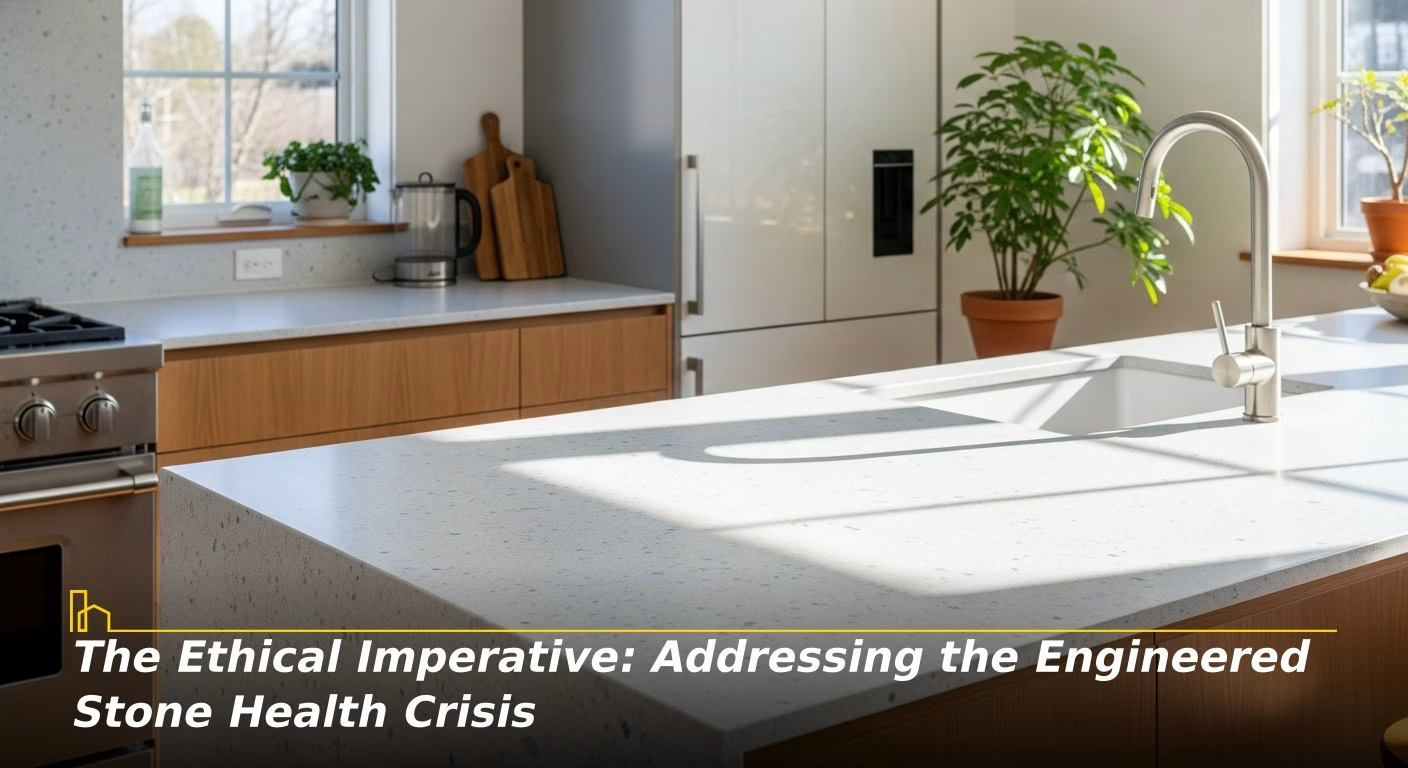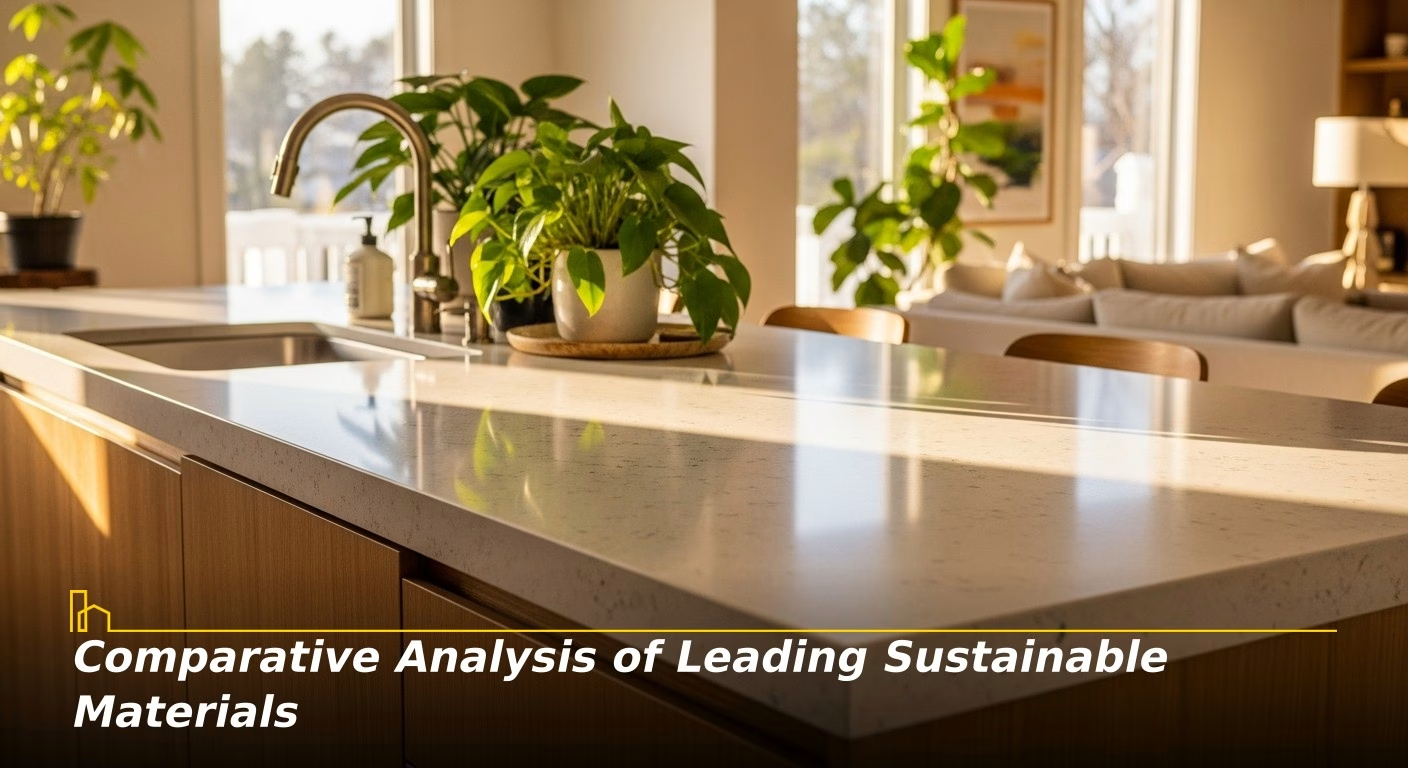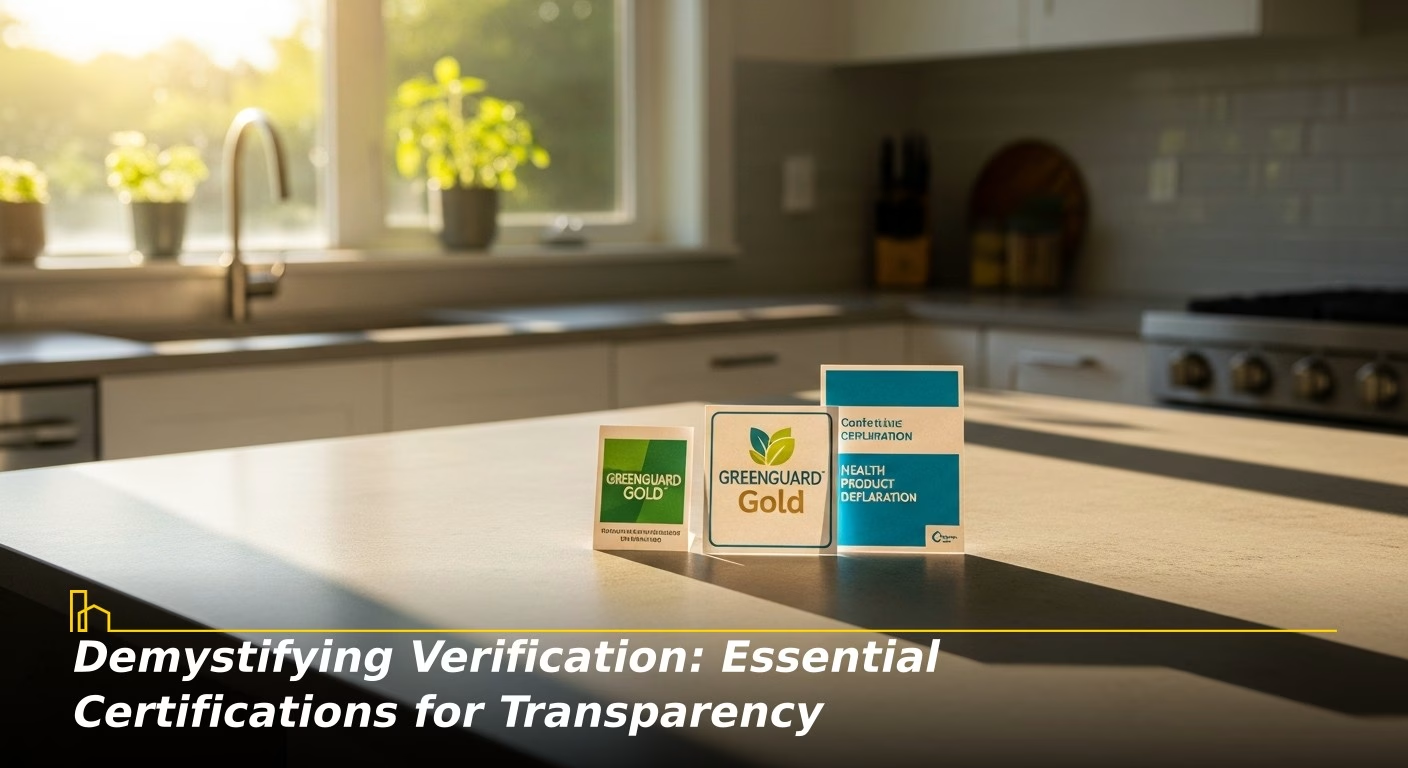Sustainable and Eco-Friendly Countertop Options: An Expert Market Analysis for Modern Kitchens
- Local Editor:Local Editor: The HOMEiA Team
Published: Nov 26, 2025
- Category: Home Improvement

In 2026, kitchen design is fundamentally defined by demonstrable environmental integrity and ethical sourcing rather than visual aesthetics. Choice of countertops, a central and highly visible element, have become powerful statement pieces regarding environmental responsibility and ethical sourcing. This market evolution reflects a fundamental paradigm shift where sustainability serves as the foundation of superior design.
Homeowners and design professionals are increasingly demanding surfaces meeting rigorous criteria established through lifecycle analysis. Our analysis considers the material’s entire journey: from its origin and the embodied energy required for its production to its decades-long durability and its eventual fate at the end of its life. The era of relying on energy-intensive, non-recyclable materials or quarrying virgin stone is opening the door to innovative solutions that combine high performance and aesthetic appeal with a truly transparent supply chain. Focusing on materials actively reducing landfill waste, lower carbon footprints, and contributing to healthier indoor air quality (IAQ).
Quartz vs. Granite Countertops: A 2026 Homeowner’s Guide
Choosing new countertops is one of the biggest decisions in any kitchen or bathroom remodel. The right surface defines the room’s look and must balance beauty, durability, and cost. For years, granite and quartz have battled for the top spot—each offering distinct advantages. The best choice ultimately depends on your lifestyle, budget, and design priorities…
Table of Contents:
I. The Ethical Imperative: Addressing the Engineered Stone Health Crisis

The conversation around sustainable materials in 2025 has been irrevocably altered by a critical health consideration concerning engineered stone, traditionally categorized as “quartz.” While often praised for its durability and inclusion of recycled content, traditional engineered stone typically contains an extremely high concentration of crystalline silica, often exceeding 90%.Their content is drastically higher than that found in natural stone alternatives, such as granite, which usually contains less than 45% silica.
When high-silica engineered stone slabs are cut, ground, or polished during fabrication and installation, large quantities of respirable crystalline silica (RCS) dust are released. Repeated exposure to this dust has triggered a documented epidemic of accelerated silicosis of severe and accelerated silicosis among fabricators and workers.
For the modern homeowner, ethical purchasing must now extend beyond environmental impact to include the protection of human health within the supply chain. Essentially, the most critical factor defining a sustainable countertop in the engineered stone category in 2025 is the mandate for low-silica or zero-silica alternatives. Next-generation engineered surfaces achieve this by replacing crystalline silica with amorphous silica (chemically similar to glass and posing less health risk) from recycled sources, or by utilizing non-silica minerals including those found in porcelain countertops. Homeowners and designers must unequivocally reject high-silica products and demand certified, healthy alternatives, ensuring their ethical purchasing aligns with social fairness and worker well-being.
II. Comparative Analysis of Leading Sustainable Materials

The market is oversaturated with high-performing sustainable materials, each offering unique benefits spanning renewability, recycled content, and exceptional longevity. This analysis compares each leading contender based on performance metrics, ethical factors, and market costs.
Key Sustainable Countertops: Performance and Ethical Metrics
Material Category | Sustainability Core | Critical Sourcing/Health Factor | Durability/Repairability | Key Maintenance Drawback |
|---|---|---|---|---|
| Butcher Block (FSC/SFI) | Renewable, low embodied energy, carbon sequestration. | Requires low-VOC, formaldehyde-free adhesives; FSC/SFI certifications. | High reparability; damage can be sanded and re-oiled. | Susceptible to water damage, heat scorching, and requires regular sealing/oiling to prevent bacteria buildup. |
| Recycled Quartz (Low/Zero Silica) | High post-consumer/industrial content; bio-resins emerging as binders. | Must be certified low or zero crystalline silica content due to fabricator health risks. | Exceptionally durable, non-porous, highly stain-resistant; requires zero sealing. | Can be damaged by excessive heat or thermal shock; visible seams. |
| Composites (Glass/Paper) | Very high recycled content (often 80-95%); diverts mass waste streams (glass, porcelain, fly ash). | Greenguard Gold verification for low VOCs. Paper types are generally not recyclable due to resin content. | Varies: Glass is hard, heatproof; Paper is softer, repairable, but limited heat resistance (up to 350°F). | Heavy; cement-bound varieties require periodic sealing; paper types require annual oiling/sealing. |
| Terrazzo (Reclaimed Aggregate) | Extreme longevity; creative reuse of reclaimed stone and glass; lower replacement cycle. | Sustainability relies heavily on aggregate source and binder type (low-dust cement or bio-epoxies). | Incredibly durable, resistant to chips and cracks; seamless installation possible; can be professionally refinished. | Critical Vulnerability: Highly susceptible to acid etching (from citrus, wine, coffee) due to calcite aggregate, which sealing does not prevent. |
| Surfaces with Reclaimed Stone Chips | Dramatically reduces quarry and fabrication waste (off-cuts, damaged slabs). | EPDs are crucial to quantify quantified environmental savings (e.g., reduced energy and water usage). | Performance depends on the original stone and binder; generally offers excellent durability. | Limited availability and fewer established suppliers compared to major material categories. |
Nuances of Material Performance
Performance of these sustainable materials often rivals or exceeds traditional surfaces, thoroughly debunking the myth that “green” means less durable. Recycled quartz and glass-based composites, for instance, are non-porous and highly resistant to stains and bacteria buildup, requiring soap and water for cleaning.
However, the specific composition dictates long-term maintenance. Butcher block, a champion of reparability, can be easily sanded and re-oiled when scratched or damaged to regain its shine—a feature unavailable to most stone or composite materials. Yet, wood requires regular maintenance, including re-oiling or sealing, to prevent water damage, rings, or bacterial accumulation, especially around wet areas (sinks). Paper-based composites offer a warm, soapstone-like aesthetic but require high heat (above F) protection and sharp implements. Cement-based terrazzo, while exceptionally durable, contains marble and calcite chips prone to permanent acid-etching from common kitchen spills like wine or lemon juice, regardless of the sealant used.
The fact that these materials offer a breathtaking array of colors, patterns, and finishes, from the sleek uniformity of engineered surfaces to the vibrant, custom look of recycled glass composites, means compromising aesthetic is no longer a factor in sustainable selection.
Aloha, e nā hoa! Let’s Talk Story About Your Healthy Hawaiian Kitchen
Eh, howzit! If you love good food, good health, and good vibes, you’re in the right place. In the islands, food is more than fuel—it’s culture, family, and our bond with the ‘āina (land). And it all starts in the kitchen. Whether you live in Honolulu, Maui, or on the mainland craving that island…
III. Demystifying Verification: Essential Certifications for Transparency

Sustainability claims gain credibility only through rigorous third-party by rigorous, third-party certification. Transparency through documentation is mandatory for assessing a material’s true environmental and health impact. Certifications act as independent data points that quantify impact and confirm ethical compliance.
1. Health and Safety Standards (Indoor Air Quality)
Increasing focus on indoor air quality (IAQ) means verifying chemical emissions is crucial, especially for materials using resins or adhesives (quartz, composites, and laminated wood).
- GREENGUARD Gold Certification: This is the benchmark for low chemical emissions. Gold certification is the stricter tier, setting limits on over 10,000 different volatile organic compounds (VOCs) and known irritants like formaldehyde and benzene.Doing so ensures the material is safe for sensitive environments, notably homes, schools, and healthcare facilities.
- Health Product Declarations (HPDs): These comprehensive documents disclose all ingredients in a product down to the 100 parts per million level. HPDs allow consumers to verify the absence of harmful VOCs, serving as a critical tool for ingredient transparency.
2. Circularity and Environmental Impact (Lifecycle Assessment)
Certifications focusing on lifecycle management ensure that environmental claims are quantifiable and verifiable, surpassing marketing claims.
- Cradle to Cradle Certified™ (C2C): Considered the gold standard for circular economy design. The C2C standard (Version 4.1, effective July 2024) assesses a product across five key pillars: Material Health, Material Reutilization (circularity), Renewable Energy & Carbon Management, Water Stewardship, and Social Fairness. Achieving this certification means products are proactively designed for safe disassembly and reuse.
- Environmental Product Declarations (EPDs): Based on a thorough lifecycle assessment, EPDs quantify a material’s environmental savings in metrics including reduced water usage, energy consumption, and global warming potential, providing an objective comparison against virgin materials.
- Forest Stewardship Council (FSC) / Sustainable Forestry Initiative (SFI): Essential for butcher block and reclaimed wood surfaces. These certifications verify that timber is sourced from responsibly managed forests preserving biodiversity while maintaining long-term ecological processes, combating illegal logging and ensuring renewable sourcing.
The existence and recognition of these verifiable standards are increasingly driving market dynamics, leading manufacturers to invest in product optimization and giving certified products a distinct competitive advantage.
Recommended for you
IV. The Long-Term Value Equation and Actionable Sourcing Strategy

Choosing sustainable countertops represents a strategic investment that maximizes long-term value, offsetting the often perceived higher initial costs associated with ethically sourced and recycled materials.
A. Addressing Consumer Concerns
- Durability and Longevity: The long-term value of these materials stems from their inherent toughness. A countertop designed to last 30 years or more—such as recycled quartz or properly sealed terrazzo—is intrinsically sustainable because it reduces the replacement cycle, keeping waste out of landfills. Non-porous materials like recycled quartz and glass composites require zero sealing and minimal maintenance, streamlining care routines.
- Cost and Resale Value: While initial costs can be higher for certain premium sustainable composites or custom terrazzo compared to low-end conventional options, this investment often enhances the resale value of a home. There’s a growing segment of homebuyers actively prioritizing properties with documented green features, viewing them as healthier, more modern, and ultimately more cost-effective to maintain over time.
- Sourcing Checklist: Interrogating the Supply Chain:
Diligent sourcing is critical to ensuring a material’s claims align with its impact. Buyers should approach suppliers with a precise set of demands:- Demand Content Metrics: Request the exact percentage of post-consumer and post-industrial recycled content in the slab. Transparency should extend to the binder; inquire about the availability of bio-based resins (derived from soy or plant materials) as an alternative to petroleum-based binders.
- Verify the Health Mandate (Silica): For any engineered stone, specifically ask for documented proof confirming low or zero crystalline silica content to ensure ethical labor practices during fabrication.
- Validate Certifications: Demand to see the most recent documentation, including EPD, HPD, or specific C2C certification level. This verifies the material’s health and environmental profile.
- Evaluate Local Practices: A holistic assessment considers the entire lifecycle, including local fabrication practices. Prioritizing locally sourced materials and fabricators who demonstrate responsible waste management—such as using water-fed tools to capture harmful dust and implementing scrap recycling programs—drastically reduces the overall embodied energy and transport footprint.
Conclusion: Designing for a Fully Circular Future
The 2025 market for eco-friendly countertops is defined by unprecedented innovation and an ethical mandate. Manufacturers are driving a decisive shift towards a circular economy utilizing massive industrial waste streams—like recycled glass, fly ash, and reclaimed stone—to create surfaces that are functionally superior and aesthetically diverse. Critically, this market now aligns consumer demand with ethical necessity, driving the rejection of high-silica engineered stone and promoting low-VOC, highly durable alternatives. Homeowners and designers are prioritizing transparency, demanding rigorous third-party certifications like Cradle to Cradle and GREENGUARD Gold to confirm a material’s lifecycle and health claims. By focusing on verifiable standards and full lifecycle assessment, the industry confirms that luxury and environmental integrity are now fundamentally inseparable.
Recommended for you
Frequently Asked Questions
1. Are eco-friendly countertops more expensive than traditional options?
Sustainable countertops sometimes carry a higher entry cost due to recycled materials and green certifications, but their durability and low maintenance often balance out costs over time. Investments in eco-friendly materials also typically enhance home resale value and long-term appeal.
2. What countertop material has the lowest environmental impact?
Recycled glass, reclaimed wood, and bamboo composites are among the lowest-impact choices, offering substantial recycled content and rapid renewability. Each reduces reliance on virgin resources while minimizing landfill waste, especially when sourced and manufactured locally.
3. How do I verify a countertop’s eco-friendly claims?
Look for clear documentation such as FSC, Cradle to Cradle, or GREENGUARD certification. Request Environmental Product Declarations (EPDs) to confirm recycled content percentages, manufacturing emissions, and chemical safety before buying.
4. Do sustainable countertops sacrifice style or performance?
Modern eco-friendly surfaces rival traditional countertops in strength, color variety, and visual impact. Advanced technology allows for unique, customizable finishes—from jewel-like recycled glass to reclaimed wood with rich patina—without compromising on daily function or longevity.
5. How can I sustainably dispose of or replace existing countertops?
When upgrading, consider resurfacing or repurposing old counters to minimize waste. A standard practice for local facilities includes recycling granite, glass, and certain composites, while donation centers may accept salvageable butcher block or stone sections for reuse.
Table of Contents:
HOMEiA is a city guide site where visitors can find detailed information about communities of interest. HOMEiA’s City Guides, created in partnership with local writers and editors, are curated lists of the best, safest, and most affordable places to live. The guides feature the HOMEiA Score, a proprietary index that rates communities on such factors as housing costs, education, employment, etc.
HOMEiA.com aims to be the premier site for people planning to relocate, providing them with insightful content and connecting them with skilled real estate professionals.
We also empower real estate professionals to establish or strengthen their web presence by highlighting their experience, knowledge and achievements. If you’re selected to join our list of certified real estate professionals, you will distinguish yourself from your peers — and earn HOMEiA’s support.
If you believe in HOMEiA’s mission, please share our website with others.



































































































































